Files in this item
Cosmic downsizing of powerful radio galaxies to low radio luminosities
Item metadata
| dc.contributor.author | Rigby, E.E. | |
| dc.contributor.author | Argyle, Joshua | |
| dc.contributor.author | Best, P.N. | |
| dc.contributor.author | Rosario, D. | |
| dc.contributor.author | Röttgering, H.J.A. | |
| dc.date.accessioned | 2015-10-09T15:39:59Z | |
| dc.date.available | 2015-10-09T15:39:59Z | |
| dc.date.issued | 2015-09 | |
| dc.identifier | 222605491 | |
| dc.identifier | c4dc52a7-548a-4cf3-bf17-b7f9bbf1c67f | |
| dc.identifier | 84941365103 | |
| dc.identifier | 000361803900096 | |
| dc.identifier.citation | Rigby , E E , Argyle , J , Best , P N , Rosario , D & Röttgering , H J A 2015 , ' Cosmic downsizing of powerful radio galaxies to low radio luminosities ' , Astronomy & Astrophysics , vol. 581 , A96 . https://doi.org/10.1051/0004-6361/201526475 | en |
| dc.identifier.issn | 0004-6361 | |
| dc.identifier.uri | https://hdl.handle.net/10023/7638 | |
| dc.description | E.E.R. acknowledges financial support from NWO (grant number: NWO-TOP LOFAR 614.001.006). E.E.R. and J.A. thank the Leiden/ESA astrophysics program for summer students (LEAPS) which supported J.A. in Leiden. | en |
| dc.description.abstract | Aims. At bright radio powers (P1.4 GHz > 1025 W/Hz) the space density of the most powerful sources peaks at higher redshift than that of their weaker counterparts. This paper establishes whether this luminosity-dependent evolution persists for sources an order of magnitude fainter than those previously studied, by measuring the steep-spectrum radio luminosity function (RLF) across the range 1024 < P1.4 GHz < 1028 W/Hz, out to high redshift. Methods. A grid-based modelling method is used in which no assumptions are made about the RLF shape and high-redshift behaviour. The inputs to the model are the same as in previous works: redshift distributions from radio source samples, together with source counts and determinations of the local luminosity function. However, to improve coverage of the radio power vs. redshift plane at the lowest radio powers, a new faint radio sample is introduced; it covers an area of 0.8 sq. deg., in the Subaru/XMM-Newton Deep Field, to a 1.4 GHz flux density limit of S1.4 GHz ≥ 100 μJy, with 99% redshift completeness. Results. The modelling results show that the previously seen high-redshift declines in space density persist to P1.4 GHz < 1025 W/Hz. At P1.4 GHz > 1026 W/Hz the redshift of the peak space density increases with luminosity, whilst at lower radio luminosities the position of the peak remains constant within the uncertainties. This cosmic downsizing behaviour is found to be similar to that seen at optical wavelengths for quasars, and is interpreted as representing the transition from radiatively efficient to inefficient accretion modes in the steep-spectrum population. This conclusion is supported by constructing simple models for the space density evolution of these two different radio galaxy classes; these models are able to successfully reproduce the observed variation in peak redshift. | |
| dc.format.extent | 7 | |
| dc.format.extent | 570119 | |
| dc.language.iso | eng | |
| dc.relation.ispartof | Astronomy & Astrophysics | en |
| dc.subject | Galaxies: active | en |
| dc.subject | Galaxies: high-redshift | en |
| dc.subject | Galaxies: evolution | en |
| dc.subject | QB Astronomy | en |
| dc.subject | QC Physics | en |
| dc.subject | NDAS | en |
| dc.subject.lcc | QB | en |
| dc.subject.lcc | QC | en |
| dc.title | Cosmic downsizing of powerful radio galaxies to low radio luminosities | en |
| dc.type | Journal article | en |
| dc.contributor.institution | University of St Andrews. School of Physics and Astronomy | en |
| dc.identifier.doi | 10.1051/0004-6361/201526475 | |
| dc.description.status | Peer reviewed | en |
This item appears in the following Collection(s)
Items in the St Andrews Research Repository are protected by copyright, with all rights reserved, unless otherwise indicated.

